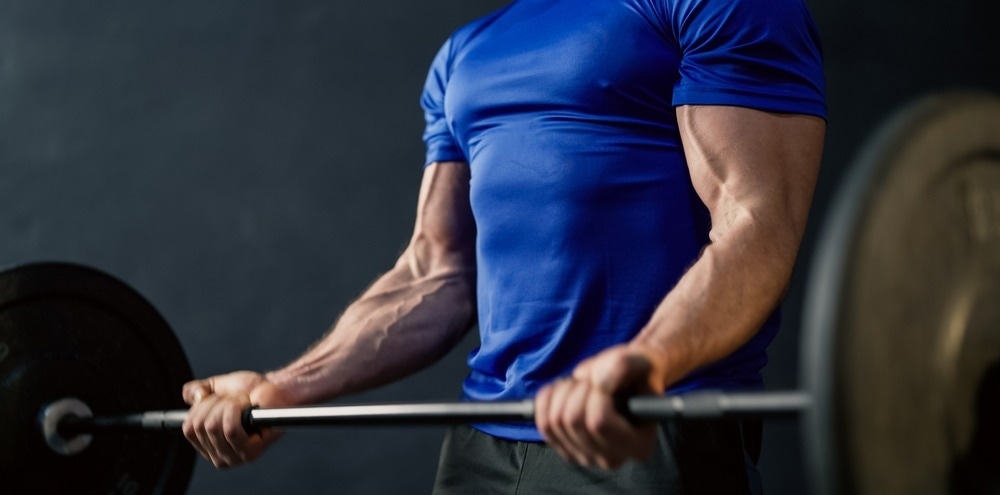Home » Health News »
How does the gut microbiome affect muscle strength?

 *Important notice: Research Square publishes preliminary scientific reports that are not peer-reviewed and, therefore, should not be regarded as conclusive, guide clinical practice/health-related behavior, or treated as established information.
*Important notice: Research Square publishes preliminary scientific reports that are not peer-reviewed and, therefore, should not be regarded as conclusive, guide clinical practice/health-related behavior, or treated as established information.
In a recent study under review at the journal Microbiome and currently posted to the Research Square* preprint server, researchers in South Korea use fecal microbiome transplantation in mouse models to examine the role of gut microbiota in determining muscle strength.

Omics eBook

Study: Identification of the intestinal microbes associated with muscle strength. Image Credit: 1st footage / Shutterstock.com
Background
A growing body of evidence indicates that the gut microbiome plays a significant role in immunity, mental health, digestion, and overall health. A plethora of diseases and disorders including inflammatory bowel disease (IBD), diabetes, obesity, cholelithiasis, sarcopenia, autism, cachexia, allergies, hepatic encephalopathy, atherosclerosis, neurological disorders such as Parkinson’s disease and Alzheimer’s disease, and even cancer are associated with gut microbiome dysbiosis.
Given the wide range of roles the gut microbiome has in physiology and health, studies have investigated the involvement of the gut microbiota in muscle strength; however, these results have been inconclusive. Furthermore, since muscle strength is also influenced by individual genetic factors, evaluating the impact of the gut microbiome on muscle strength in humans is difficult.
However, mouse models allow genetic factors to be controlled, thus making them ideal systems to examine how the gut microbiota contributes to muscle strength.
About the study
In the present study, the researchers developed a method in which muscle strength was evaluated in the same mouse before and after the gut microbiome was remodeled using fecal microbiome transplantation, which eliminated the possibility of individual genetic variation.
Fecal samples were collected from 10 healthy human volunteers and combined to produce a fecal medium containing a mix of human gut microbiota. This fecal medium was administered to C57BL/6 mice models through oral gavage twice each week for three months.
Each mouse was weighed, with blood and fecal samples collected after each round of fecal microbiome transplantation. Mice were maintained in a controlled environment for three months more after the final fecal microbiome transplantation. On the last day of the experiment, blood and fecal samples were collected and mice were weighed.
A rotarod apparatus consisting of a rotating rod mounted on a base was used to assess the strength, motor coordination, and balance of each mouse. The apparatus works by rotating the rod at increasing speeds and detecting the time until each mouse falls off of the rod. Mice were subjected to trial runs before undergoing the final test.
Additionally, biochemical parameters such as triglycerides, high-density lipoproteins, and total cholesterol levels were assessed in the blood samples of all mice. Blood glucose levels were also analyzed.
Muscle tissue samples from the mice were also subjected to histological analyses. Furthermore, bacterial genome deoxyribonucleic acid (DNA) was extracted and subjected to metagenome sequencing to amplify the 16s ribosomal ribonucleic acid (rRNA) region.
Results
The impact of the gut microbiomes on muscle strength varied based on the diversity and microbial composition.
Notably, fecal microbiome transplantation studies showed that the human gut microbiome has higher phylogenetic, alpha, and beta diversities as compared to the gut microbiomes of mice.
At the end of the experimental period, mice could be broadly categorized into three groups based on changes in muscle strength including increased muscle strength, unchanged muscle strength, and decreased muscle strength. This classification was based on their performance on the rotarod apparatus and histological examinations to confirm muscle fiber accumulation. The gut microbiome composition of each group was found to be different.
Phylogenetic analyses were unable to identify specific bacterial groups that correlated with higher or lower muscle strength. However, based on a linear correlation with bacterial abundance and fold change with respect to changes in muscle strength, the association of certain species and phyla with changes in muscle strength was identified.
The bacterial species Anaeroplasma abactoclasticum, Eisenbergiella massiliensis, and Phocaeicola barnesiae were positively correlated with muscle strength, while Ethanoligenens harbinense and Ileibacterium valens had a negative impact on muscle strength. The bacterial phyla Bacteroidetes, Tenericutes, and Firmicutes were associated with increased muscle strength; however, some Firmicutes bacteria were also linked to reduced muscle strength.
Conclusions
Overall, the current study established a connection between gut microbiome composition and muscle strength. Moreover, the researchers introduced a novel method to investigate the effect of gut microbiomes on different physiological factors while eliminating the potential impact of individual genetic variations.
The study findings showed that certain phyla of bacteria such as Bacteroidetes and Tenericutes are associated with improved muscle strength, while different species of the phylum Firmicutes contributed contrastingly to muscle strength.

 *Important notice: Research Square publishes preliminary scientific reports that are not peer-reviewed and, therefore, should not be regarded as conclusive, guide clinical practice/health-related behavior, or treated as established information.
*Important notice: Research Square publishes preliminary scientific reports that are not peer-reviewed and, therefore, should not be regarded as conclusive, guide clinical practice/health-related behavior, or treated as established information.
- Preliminary scientific report. Ahn, J., Koo, B., Choi, Y., et al. (2023). Identification of the intestinal microbes associated with muscle strength. Research Square. doi:10.21203/rs.3.rs-2649903/v1. https://www.researchsquare.com/article/rs-2649903/v1.
Posted in: Men's Health News | Medical Science News | Life Sciences News | Medical Research News | Women's Health News
Tags: Atherosclerosis, Autism, Bacteria, Blood, Cachexia, Cancer, Cholelithiasis, Cholesterol, Diabetes, Digestion, DNA, Dysbiosis, Encephalopathy, Genetic, Genome, Glucose, Hepatic Encephalopathy, High-Density Lipoproteins, immunity, Inflammatory Bowel Disease, Mental Health, Microbiome, Muscle, Obesity, Physiology, Research, Ribonucleic Acid, Sarcopenia
.jpg)
Written by
Dr. Chinta Sidharthan
Chinta Sidharthan is a writer based in Bangalore, India. Her academic background is in evolutionary biology and genetics, and she has extensive experience in scientific research, teaching, science writing, and herpetology. Chinta holds a Ph.D. in evolutionary biology from the Indian Institute of Science and is passionate about science education, writing, animals, wildlife, and conservation. For her doctoral research, she explored the origins and diversification of blindsnakes in India, as a part of which she did extensive fieldwork in the jungles of southern India. She has received the Canadian Governor General’s bronze medal and Bangalore University gold medal for academic excellence and published her research in high-impact journals.
Source: Read Full Article



